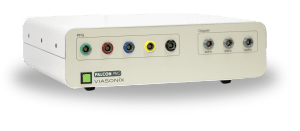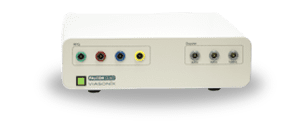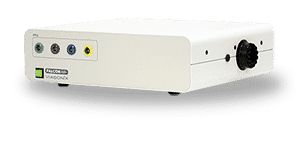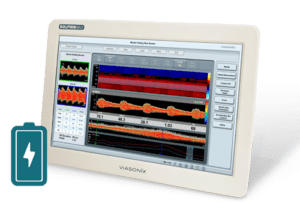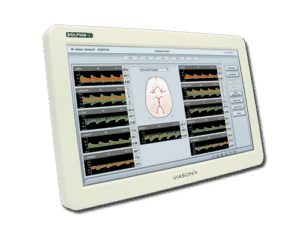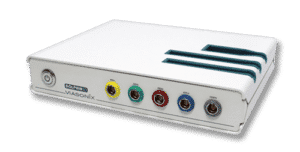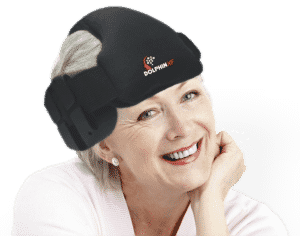What is Intraoperative TCD Monitoring?
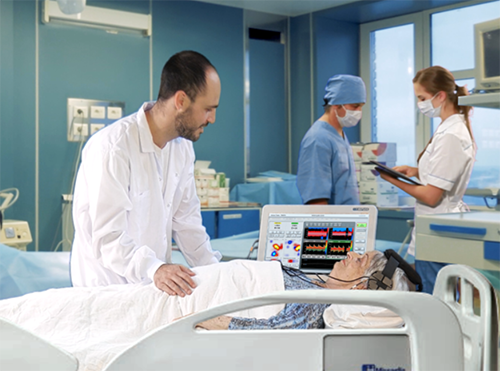
Intraoperative TCD measurements are designed to ensure proper blood supply to the brain throughout the surgery, count the number of emboli that pass to the brain and monitor various specific procedures during the surgical process.
For these reasons, both anesthesiologists and surgeons are particularly interested in Intraoperative monitoring.
Clinical Importance of Intraoperative Monitoring
Transcranial Doppler sonography is often considered the stethoscope to the brain because it is the only modality that allows measuring cerebral blood flow in a simple and non-invasive manner.
While measuring and monitoring blood flow to the brain is critical during operation, this parameter is often the only essential parameter that is not measured. The reasons for not measuring it includes:
- Lack of expertise and personnel to operate the Transcranial Doppler equipment in the OR
- Lack of enough space in the tight operating rooms.
Finally, the critical importance of TCD intraoperative monitoring is well documented by: Ryan Hakimi, Andrei V. Alexandrov, and Zsolt Garami, in Neuro-ultrasonography (Neurol Clin 38 (2020) 215–229): “The use of intraoperative TCD during carotid endarterectomy and stenting allows optimal intraoperative hemodynamic management while minimizing the risk for brain ischemia”.
How to use TCD for Intraoperative Monitoring
Intraoperative monitoring with TCD in the operating room is performed outside the sterile field. Usually, the Transcranial Doppler machine is placed near the anesthesiologist, which is located behind the patient’s head.
TCD monitoring is typically performed bilaterally on both the right and left sides of the temporal window. The Doppler probe frequency used with the TCD equipment during monitoring is normally the standard 2 MHz probes.
The 2MHz probes are fixed to the head with a dedicated headset or headgear equipment. Finding the MCA (Middle Cerebral artery) blood flow velocities and fixing the probes in place can be done either manually or with the aid of automated robots that scan the temporal region and identify the cerebral flow automatically.
It’s important to note that while all TCD manufacturers have the manual monitoring headset equipment, only a selected few have designed the Transcranial Doppler robotic probe scanning solution in addition to the standard headset placement.
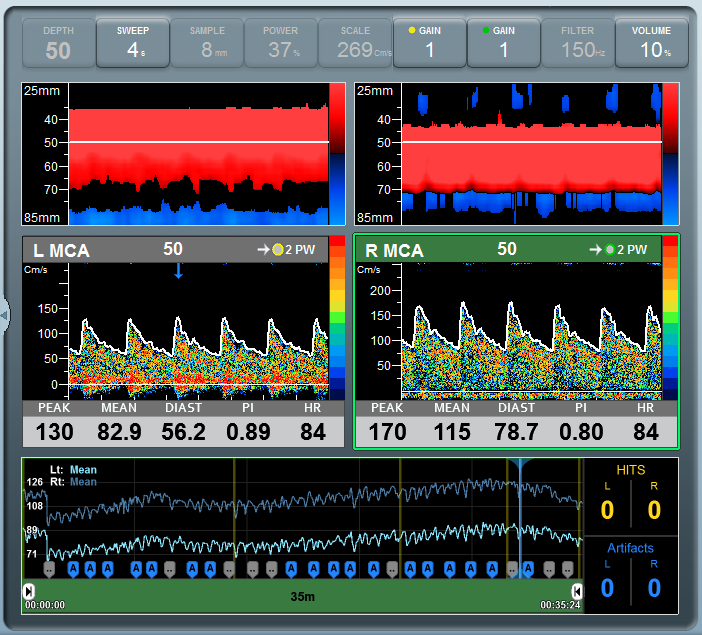
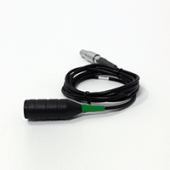
2 MHz Doppler Probe
High quality and ultra sensitive Doppler probe
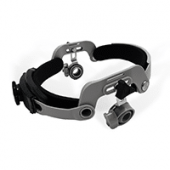
Monitoring Headset
Perform Monitoring Bilaterally
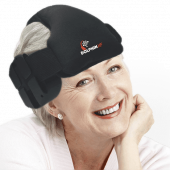
Robotic Probe
Fast, Stable, and Comfortable Monitoring
Using the Dolphin TCD for Intraoperative Monitoring
The Dolphin is a TCD machine that is uniquely designed to allow fast and effective monitoring of cerebral blood flow in the operating room for various surgical procedures. The monitoring fixation equipment includes:
- The standard monitoring headgear with manual fixation, and
- The automated TCD robotic probe with advanced technology to identify and monitor blood flow to the brain quickly.
The monitoring headgear of the Dolphin TCD machines includes a unique fast clamp locking mechanism. This unique design replaces the standard screws often required in other TCD devices and eliminates the movement of the probe relative to the skin once the blood flow velocity is identified.
The Dolphin/XF transcranial doppler robotic probe is the most advanced robot available with transcranial doppler machines. It is designed in a way that practically anyone from the medical staff can quickly and easily place it on the patient’s head. This design is a critical advantage since in cases where an experienced TCD sonographer or technician is not available, TCD intraoperative monitoring can still be used with the anesthesiologist or with standard staff in the operating room.
The advanced software of the Dolphin TCD equipment allows a wide range of monitoring options designed to meet the specific needs of each surgical procedure. So, whether the procedure is carotid endarterectomy, cardiac or coronary bypass surgery, orthopedic, or any other surgery, the Dolphin TCD monitoring capabilities allow configuration to meet the specific needs. Measurements are, of course, bilateral and provide a continuous display of changes in blood flow velocities and pulsatility indices, as well as a continuous count of embolic events (HITS, high intensity transient signals).
Expected Results of Intraoperative TCD Monitoring
Intraoperative TCD monitoring is primarily focused on ensuring that blood flow to the brain is not impaired or stopped during the operation. Sharp changes in velocity can suggest equivalent changes in volume blood flow, which may put the brain at high risk. Of particular interest are abnormal low flow rates to the brain.
Additionally, the focus of intraoperative monitoring can be to assess the effect of various clinical and surgical perturbations during the surgery. These may include, for example, going on- or off the pump, clamping or releasing an aortic or another vascular clamp, the effects of medication, etc.
Another focus of intraoperative Transcranial Doppler monitoring is to count the number of emboli that travel in the bloodstream towards the brain. A high embolic count can suggest the potential for post-surgery neurological deficits. The ability of the surgeon to modify the actions taken during the operation can help decrease the number of emboli in future procedures.
Selected Literature for Intraoperative TCD Monitoring
Transcranial Doppler ultrasonography in neurological surgery and neurocritical care, Robert H. Bonow, Christopher C. Young, David I. Bass, Anne Moore, and Michael R. Levitt, Neurosurg Focus 47 (6):E2, 2019
Transcranial Doppler ultrasonography in anaesthesia and intensive care, I. K. Moppett and R. P. Mahajan, British Journal of Anaesthesia 93 (5): 710–24 (2004)
Association of Intraoperative Transcranial Doppler Monitoring Variables With Stroke From Carotid Endarterectomy, Ackerstaff, Moons, van de Vlasakker, Moll, Vermeulen, Algra, and M. P. Spencer, Stroke. 2000;31:1817–1823
Cerebral monitoring during carotid endarterectomy by transcranial Doppler ultrasonography, Woo-Sung Yun, Ann Surg Treat Res 2017;92(2):105-109
An Observational Study of Cerebral Blood Flow Velocity During Hypotensive Epidural Anesthesia, Anna Maria Bombardieri, Nigel E. Sharrock, Yan Ma, George Go, and John C. Drummond, Anesth Analg 2016;122:226–33
Neuro-ultrasonography, Ryan Hakimi, Andrei V. Alexandrov, and Zsolt Garami, Neurol Clin 38 (2020) 215–229
Transcranial Doppler, Review Article, Manish K. Marda, Hemanshu Prabhakar, J Neuroanaesthesiol Crit Care 2015;2:215-20
Disclaimer of Information & Content
The content of Viasonix Ltd. website is for information only, not advice or guarantee of outcome. Information is gathered and shared from reputable sources; however, Viasonix Ltd. Management is not responsible for errors or omissions in reporting or explanation. No individuals, including those under our active care, should use the information, resources or tools contained within this self-diagnosis or self-treat any health-related condition. Viasonix Ltd. Management gives no assurance or warranty regarding the accuracy, timeliness or applicability or the content.
